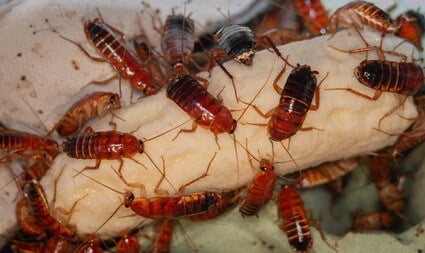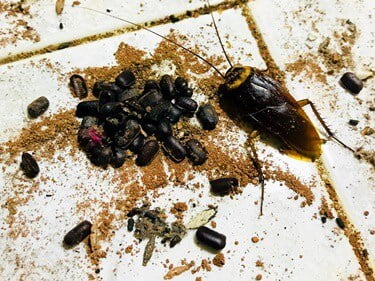Cockroaches are hard to remove because they breed and multiply so quickly. Killing them isn’t always effective because there are usually oothecae getting ready to hatch elsewhere. These are hard casings that keep roach eggs safe from dangers, such as poisons and predators.
Two German cockroaches and their babies can produce over 300,000 offspring over their lifetimes. However, most roaches produce 200 to 300 offspring in a year. The reason roaches are so hard to eradicate is because most species don’t carry their eggs but deposit them somewhere safe where predators can’t find them.
Cockroaches require a suitable environment to breed, giving them access to shelter, food, and water. Cockroaches stop reproducing if they can’t fit the environment. If the colony becomes too big and food competition kicks in, they’ll move onto another domain or begin cannibalizing each other to survive.
How Fast Can Roaches Multiply?
All cockroach species reproduce and multiply at different speeds, but most female cockroaches can produce 6-14 oothecae in their lifetimes. A single ootheca casing holds approximately 16 individual eggs containing a single nymph roach inside. Unfortunately, this means that an infestation can become out of control in a short period of time.
If you don’t deal with the infestation quickly, a small roach infestation can turn into a significant problem, becoming out of control in a short space of time. German cockroaches are also becoming resistant to most common pesticides, making it difficult to eradicate the colony with only chemical insecticides. Instead, other integrated pest control methods are needed, such as:
- Traps
- Cleaning debris off surfaces
- Vacuuming up the pests
- Chemical treatments

How Often Do Cockroaches Lay Eggs?
As mentioned, different species have different reproduction rates. If you’re wondering, “how many eggs do cockroaches lay?” the most common cockroach species found in homes produce the following number of nymphs:
German Cockroaches
German cockroaches are the most common household roach species and reproduce much faster than all others. A female can lay a single ootheca holding up to 50 eggs a month, but on average, most German cockroaches give birth six times per year. This means a single German roach can produce as many as 350 nymphs in her lifetime. They only take 24 hours to hatch and go from eggs to adults in only 90 days, making them a highly invasive pest species.
American Cockroaches
According to the University of Florida, the average American cockroach produces one case a month for ten months, laying 16 eggs per case. However, during the peak of their reproductive period, American roaches can produce two oothecae per week, with most giving birth to between 150-225 nymphs in their lifetime.
Oriental Cockroaches
Oriental cockroaches only live for approximately 180 days and produce up to eight oothecae containing 16 eggs while they’re alive. Some have been known to produce up to 16 oothecae. They carry their egg capsules for approximately 12 hours to five days before depositing them somewhere safe.
It takes 185 days for male Oriental cockroach nymphs to mature and 216 for the females. As a result, a single female roach can produce up to 128 cockroaches in her lifetime.
Brown-Banded Cockroaches
Female brown-banded cockroaches lay 6-8 oothecae containing 16-18 eggs at a time. They have a hatch rate of 13.2%, so they are not as invasive as other cockroach species.
Do Cockroaches Lay Eggs When Killed?
There’s a widespread belief that cockroaches lay eggs as they die, especially once they’re squished. The reality is cockroaches won’t release their ootheca when they’re stepped on. That’s because they deposit their ootheca onto hard surfaces to keep them safe. If a female roach were to die, the ootheca would remain unaffected and hatch regardless. Species that carry out this behavior with their oothecae include:
- American cockroaches
- Oriental cockroaches
- Smoky brown cockroaches
- Brown-banded cockroaches
Female cockroaches have been known to expel their eggs while dying to protect their bloodline. However, other cockroach species, such as German roaches, attach their ootheca to their abdomens, carrying them around until the nymphs hatch. If you squish a cockroach with eggs inside her, though, they likely won’t survive.
Similarly, depending on how close the nymphs were to hatching, they can break from the ootheca and emerge from the mother’s body. If the eggs aren’t developed enough when the mother roach dies, they’ll stagnate and die.

How Fast Do Roaches Spread?
Cockroaches spread faster than most other household pests. Their ability to breed and reproduce so quickly is one of the main reasons they’ve been able to survive since the Carboniferous period 320 million years ago.
Once a male and female cockroach mate, it can take as little as 30 days for the reproduction process to finish. Growth increases when the temperature reaches 30º (85º F) but slows down at 15 (60º F). That’s why pest control professionals recommend keeping houses cold to reduce the rate of reproductive growth. You can also put infested appliances in the freezer or a cold room to drive cockroaches out.
However, while roaches spread fast, they limit the colony population depending on the size of their environment and how much food and water are available. Food competition is one of the most significant reasons why cockroaches stop reproducing. If they don’t have enough food, they cannibalize each other, which doesn’t benefit the colony. Once the colony becomes too big, cockroaches relocate to a larger location.
If left to breed, roaches can occupy their full living space within a month. They also recover quickly. Because roaches deposit their ootheca in safe areas, the colony will continue, even if homeowners lay poison baits and traps. The ootheca does a great job of protecting the nymphs from harm, continuing the colony, and ensuring its survival.
When it comes to a cockroach infestation, the reality is that if you see a lone cockroach, there’s likely to be more lurking nearby, waiting to hatch. That’s why you should never delay in dealing with cockroaches in your home.




